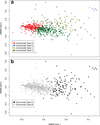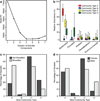Dynamics and associations of microbial community types across the human body
- PMID: 24739969
- PMCID: PMC4139711
- DOI: 10.1038/nature13178
Dynamics and associations of microbial community types across the human body
Abstract
A primary goal of the Human Microbiome Project (HMP) was to provide a reference collection of 16S ribosomal RNA gene sequences collected from sites across the human body that would allow microbiologists to better associate changes in the microbiome with changes in health. The HMP Consortium has reported the structure and function of the human microbiome in 300 healthy adults at 18 body sites from a single time point. Using additional data collected over the course of 12-18 months, we used Dirichlet multinomial mixture models to partition the data into community types for each body site and made three important observations. First, there were strong associations between whether individuals had been breastfed as an infant, their gender, and their level of education with their community types at several body sites. Second, although the specific taxonomic compositions of the oral and gut microbiomes were different, the community types observed at these sites were predictive of each other. Finally, over the course of the sampling period, the community types from sites within the oral cavity were the least stable, whereas those in the vagina and gut were the most stable. Our results demonstrate that even with the considerable intra- and interpersonal variation in the human microbiome, this variation can be partitioned into community types that are predictive of each other and are probably the result of life-history characteristics. Understanding the diversity of community types and the mechanisms that result in an individual having a particular type or changing types, will allow us to use their community types to assess disease risk and to personalize therapies.
Figures






References
Publication types
MeSH terms
Substances
Grants and funding
LinkOut - more resources
Full Text Sources
Other Literature Sources
Medical

